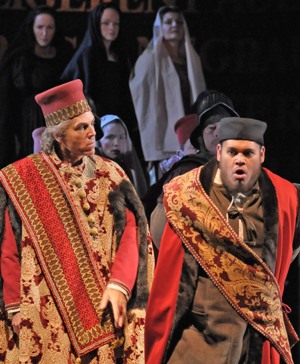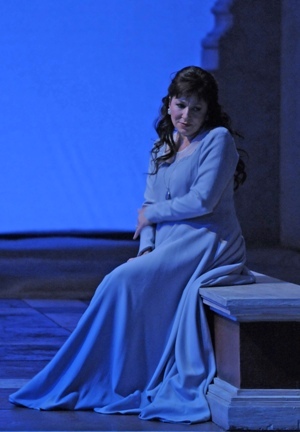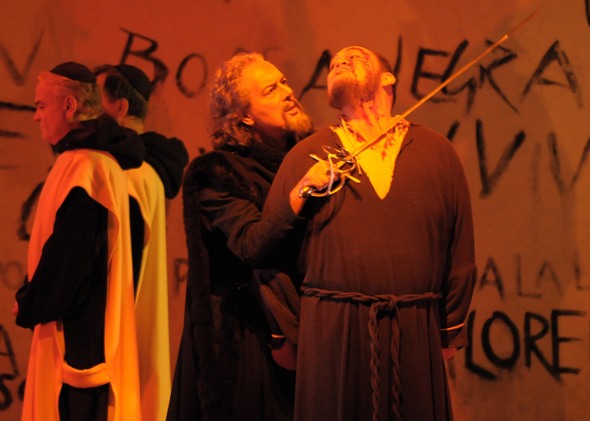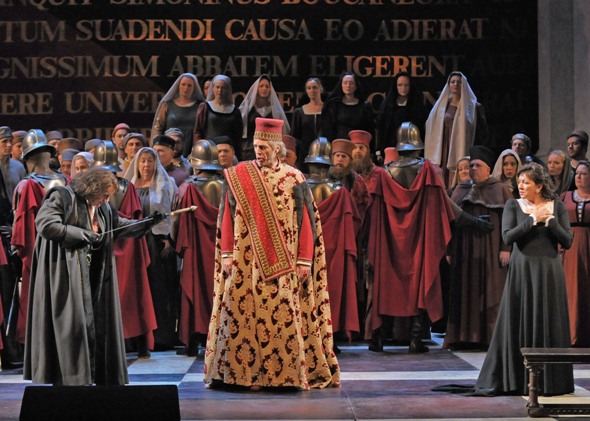Thomas Hampson’s regal turn sets tone for ‘Simon Boccanegra’ at Lyric Opera
 “Simon Boccanegra,” by Giuseppe Verdi, in Italian with English surtitles, at the Lyric Opera of Chicago through Nov. 9. ★★★★
“Simon Boccanegra,” by Giuseppe Verdi, in Italian with English surtitles, at the Lyric Opera of Chicago through Nov. 9. ★★★★
By Nancy Malitz
Late in his career the opera composer Giuseppe Verdi, like playwright William Shakespeare, was arguably at his best depicting the challenges and torment of life past its midpoint. Not that young lovers’ passionate insanity went uncelebrated. It’s just that young love was a counter thread to other, more compelling yarns of human folly.
 Each time I sit through the glorious Council Chamber Scene of “Simon Boccanegra,” now playing at Chicago’s Lyric Opera, I find myself wishing Verdi had been able to compose a work on Shakespeare’s “King Lear,” as he long desired. With Arrigo Boito, the poet-lyricist-collaborator of Verdi’s later years, the result would doubtless have been surpassing.
Each time I sit through the glorious Council Chamber Scene of “Simon Boccanegra,” now playing at Chicago’s Lyric Opera, I find myself wishing Verdi had been able to compose a work on Shakespeare’s “King Lear,” as he long desired. With Arrigo Boito, the poet-lyricist-collaborator of Verdi’s later years, the result would doubtless have been surpassing.
“Simon Boccanegra” tells the tragic tale of a 14th century pirate who became Doge of Genoa and reigned for decades while hatred festered in thwarted rivals, including one of great nobility. The Lyric Opera of Chicago has remounted its lavish 1995 production, a collaboration with Royal Opera Covent Garden, under the psychologically insightful stage direction of Elijah Moshinsky, whose long familiarity with this work brings great rewards.
If fate seemed to be knocking at the door at peculiar moments on Lyric’s opening night, you can’t blame the deeply satisfying musical leadership of conductor Andrew Davis. The sounds weren’t coming from his orchestra, which soared, but rather from mechanical noises that seemed to emanate from the aged building’s bowels, tentatively diagnosed by insiders as the groans of the heating system. With a somewhat intensified orchestral palette, Davis drew attention away from the bother and toward the intelligence and artistry of two great rivals – American baritone Thomas Hampson as the powerful Doge, whose past is about to throw him a curve, and Italian bass Ferruccio Furlanetto as the vengeful Fiesco, who has more in common with the hated Boccanegra than he knows.
 It’s in the Council Chamber Scene that the broad interplay of classes, generations and destinies builds toward its harrowing midpoint. Verdi and Boito abandoned traditional formulas and created a vast, breathtakingly complex dramatic canvas, upon which Hampson is skillfully at ease. Hampson’s Doge seems quite the modern ruler, managing fickle crowds and conflicting factions like a practiced master, even as he is personally shattered by revelations of a daughter’s loyalties and a former favorite’s treason.
It’s in the Council Chamber Scene that the broad interplay of classes, generations and destinies builds toward its harrowing midpoint. Verdi and Boito abandoned traditional formulas and created a vast, breathtakingly complex dramatic canvas, upon which Hampson is skillfully at ease. Hampson’s Doge seems quite the modern ruler, managing fickle crowds and conflicting factions like a practiced master, even as he is personally shattered by revelations of a daughter’s loyalties and a former favorite’s treason.
Hampson has called this opera “Verdi for adults,” and Simon’s great aria of brotherhood, “Plebe! Patrizi! Popolo,” sung to opposing forces as they begin to draw arms against each other, is everything you could want from such a masterpiece of sustained tension between the public persona and the private man. Now 57, Hampson fully inhabits the interior life of this severe authoritarian as personal tragedy overtakes him, and we hear it in fine musical and poetic detail as wisdom is achieved, the voice strains and the body dissolves.
 But the success of Lyric’s current production owes credit as well to other singing actors who also know this opera cold. The scenes between Hampson’s Simon and Furlanetto’s Fiesco feel as real as if you are standing by helpless to prevent two good friends from destroying each other, and their singing together was the finest of the night. (Furlanetto’s grief-stricken “Il lacerato spirito,” in which Fiesco rages blasphemously over the death of his daughter, brought down the house.)
But the success of Lyric’s current production owes credit as well to other singing actors who also know this opera cold. The scenes between Hampson’s Simon and Furlanetto’s Fiesco feel as real as if you are standing by helpless to prevent two good friends from destroying each other, and their singing together was the finest of the night. (Furlanetto’s grief-stricken “Il lacerato spirito,” in which Fiesco rages blasphemously over the death of his daughter, brought down the house.)
Bulgarian soprano Krassimira Stoyanova was vocally quite ravishing as Simon’s long lost daughter, once she worked through some ordinariness as her voice warmed up. American tenor Frank Lopardo captured the changeable intensity of her young lover, whose views of right and wrong, honorable and dishonorable, undergo swift alterations. American baritone Quinn Kelsey, in a breakout character role, was a terrifying powerhouse as Simon’s chafing former ally Paolo. And the chorus, under the direction of Martin Wright, was strong throughout.
“Simon Boccanegra” is not as well known as Verdi’s mid-career romantic operas, but it is becoming a staple, and Chicago’s Lyric Opera deserves considerable credit for its advocacy. The handsome openness and simplicity of Michael Yeargan’s sets keep this production looking like new despite its years; the concept wears well, especially with Peter J. Hall’s brocade-rich costumes.
Now playing at the Lyric for the seventh time in its history, the opera has starred Titto Gobbi, Piero Cappuccilli, Sherrill Milnes and Alexandre Agache before Hampson. The opera’s complex plotline is sometimes criticized, but really, the music’s marvelous. The rest is just a matter of familiarity. Besides, compared to thorny entanglements of “Il Trovatore,” the story of “Simon Boccanegra” is a walk in the park.
Related Links:
- Performance location, dates and times: Go to LyricOpera.org
- Lyric Opera season preview: Read it at ChicagoOntheAisle.com
- The Lyric’s first production of “Simon Boccanegra” starred Piero Cappuccilli: Check out the cast
- There was really a Boccanegra who was Doge of Genoa: But his story differs
Photo captions and credits: Home page and top: Simon Boccanegra (Thomas Hampson) has long ruled the patricians and plebians of Genoa, where he is Doge. As a young pirate in love, Simon (Thomas Hampson) impregnated the daughter of Fiesco (Ferruccio Furlanetto), bringing shame and tragedy to a noble family. Simon (Thomas Hampson) unleashes his wrath on former ally Paolo (Quinn Kelsey). Amelia (Krassimira Stoyanova) is both Fiesco’s ward and Simon’s long-lost daughter. Below: Fiesco (Ferruccio Furlanetto) and Paolo (Quinn Kelsey) both hate Simon, but Fiesco won’t stoop to Paolo’s tactics. Gabriele Adorno (Frank Lopardo) learns that Simon (Thomas Hampson) is the father of Amelia (Krassimira Stoyanova) and begs pardon. (Production photos by Dan Rest/Lyric Opera)
Tags: Arrigo Boito, Elijah Moshinsky, Ferruccio Furlanetto, Frank Lopardo, Giuseppe Verdi, Krassimira Stoyanova, Lyric Opera of Chicago, Martin Wright, Michael Yeargan, Peter J. Hall, Quinn Kelsey, Royal Opera Covent Garden, Simon Boccanegra, Sir Andrew Davis, Thomas Hampson



